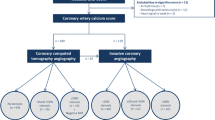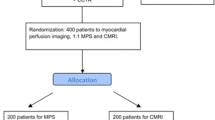Abstract
Recent guidelines recommend a risk-adjusted, non-invasive work-up in patients presenting with chest discomfort to exclude coronary artery disease (CAD). However, a risk-adjusted diagnostic approach remains challenging in clinical practice. An acoustic detection device for analyzing micro-bruits induced by stenosis-generated turbulence in the coronary circulation has shown potential for ruling out CAD in patients with low-to-intermediate likelihood. We examined the diagnostic value of this acoustic detection system in a high-prevalence cohort. In total, 226 patients scheduled for clinically indicated invasive coronary angiography (ICA) were prospectively enrolled at two centers and examined using a portable, acoustic detection system. The acoustic analysis was performed in double-blinded fashion prior to quantitative ICA and following percutaneous coronary intervention (PCI). An acoustic detection result (CAD score) was obtained in 94% of all patients. The mean baseline CAD score was 41.2 ± 11.9 in patients with obstructive CAD and 33.8 ± 13.4 in patients without obstructive CAD (p < 0.001). ROC analysis revealed an AUC of 0.661 (95% CI 0.584–0.737). Sensitivity was 97.6% (95% confidence interval (CI) 91.5–99.7%), specificity was 14.5% (CI 9.0–21.7%), negative predictive value was 90.5% (CI 69.6–98.8%), and positive predictive value was 41.7% (CI 34.6–49.0%). Following PCI, the mean CAD score decreased from 40.5 ± 11.2 to 38.3 ± 13.7 (p = 0.039). Using an acoustic detection device identified individuals with CAD in a high-prevalence cohort with high sensitivity but relatively low specificity. The negative predictive value was within the predicted range and may be of value for a fast rule-out of obstructive CAD even in a high-prevalence population.




Similar content being viewed by others
References
Knuuti J, Wijns W, Saraste A, Capodanno D, Barbato E, Funck-Brentano C, Prescott E, Storey RF, Deaton C, Cuisset T, Agewall S, Dickstein K, Edvardsen T, Escaned J, Gersh BJ, Svitil P, Gilard M, Hasdai D, Hatala R, Mahfoud F, Masip J, Muneretto C, Valgimigli M, Achenbach S, Bax JJ, ESC scientific document group (2020) 2019 ESC guidelines for the diagnosis and management of chronic coronary syndromes. Eur Heart J 41:407–477
Min JK, Gilmore A, Jones EC, Berman DS, Stuijfzand WJ, Shaw LJ, O’Day K, Danad I (2017) Cost-effectiveness of diagnostic evaluation strategies for individuals with stable chest pain syndrome and suspected coronary artery disease. Clin Imaging 43:97–105
Fujimoto S, Kondo T, Yamamoto H, Yokoyama N, Tarutani Y, Takamura K, Urabe Y, Konno K, Nishizaki Y, Shinozaki T, Kihara Y, Daida H, Isshiki T, Takase S (2015) Development of new risk score for pre-test probability of obstructive coronary artery disease based on coronary CT angiography. Heart Vessels 30:563–571
Makaryus AN, Makaryus JN, Figgatt A, Mulholland D, Kushner H, Semmlow JL, Mieres J, Taylor AJ (2013) Utility of an advanced digital electronic stethoscope in the diagnosis of coronary artery disease compared with coronary computed tomographic angiography. Am J Cardiol 111:786–792
Dock W, Zoneraich S (1967) A diastolic murmur arising in a stenosed coronary artery. Am J Med 42:617–619
Winther S, Schmidt SE, Holm NR, Toft E, Struijk JJ, Bøtker HE, Bøttcher M (2016) Diagnosing coronary artery disease by sound analysis from coronary stenosis induced turbulent blood flow: diagnostic performance in patients with stable angina pectoris. Int J Cardiovasc Imaging 32:235–245
Thomas JL, Winther S, Wilson RF, Bøttcher M (2017) A novel approach to diagnosing coronary artery disease: acoustic detection of coronary turbulence. Int J Cardiovasc Imaging 33:129–136
Schmidt SE, Winther S, Larsen BS, Groenhoej MH, Nissen L, Westra J, Frost L, Holm NR, Mickley H, Steffensen FH, Lambrechtsen J, Nørskov MS, Struijk JJ, Diederichsen ACP, Boettcher M (2019) Coronary artery disease risk reclassification by a new acoustic-based score. Int J Cardiovasc Imaging 35:2019–2028
Winther S, Nissen L, Schmidt SE, Westra JS, Rasmussen LD, Knudsen LL, Madsen LH, Kirk Johansen J, Larsen BS, Struijk JJ, Frost L, Holm NR, Christiansen EH, Botker HE, Bøttcher M (2018) Diagnostic performance of an acoustic-based system for coronary artery disease risk stratification. Heart 104:928–935
Schmidt SE, Holst-Hansen C, Hansen J, Toft E, Struijk JJ (2015) Acoustic features for the identification of coronary artery disease. IEEE Trans Biomed Eng 62:2611–2619
Schmidt SE, Holst-Hansen C, Graff C, Toft E, Struijk JJ (2010) Segmentation of heart sound recordings by a duration-dependent hidden Markov model. Physiol Meas 31:513–529
Schmidt SE, Hansen J, Zimmermann NH, Hammershøi D, Toft E, Struijk JJ (2011) Coronary artery disease and low frequency heart sound signatures. Comput Cardiol 38:481–484
Authors/Task Force members, Windecker S, Kolh P, Alfonso F, Collet JP, Cremer J, Falk V, Filippatos G, Hamm C, Head SJ, Jüni P, Kappetein AP, Kastrati A, Knuuti J, Landmesser U, Laufer G, Neumann FJ, Richter DJ, Schauerte P, Sousa Uva M, Stefanini GG, Taggart DP, Torracca L, Valgimigli M, Wijns W, Witkowski A (2014) 2014 ESC/EACTS guidelines on myocardial revascularization: the task force on myocardial revascularization of the european society of cardiology (ESC) and the European association for cardio-thoracic surgery (EACTS) developed with the special contribution of the European association of percutaneous cardiovascular interventions (EAPCI). Eur Heart J 35:2541–2619
Genders TS, Steyerberg EW, Alkadhi H, Leschka S, Desbiolles L, Nieman K, Galema TW, Meijboom WB, Mollet NR, de Feyter PJ, Cademartiri F, Maffei E, Dewey M, Zimmermann E, Laule M, Pugliese F, Barbagallo R, Sinitsyn V, Bogaert J, Goetschalckx K, Schoepf UJ, Rowe GW, Schuijf JD, Bax JJ, de Graaf FR, Knuuti J, Kajander S, van Mieghem CA, Meijs MF, Cramer MJ, Gopalan D, Feuchtner G, Friedrich G, Krestin GP, Hunink MG, CAD Consortium (2011) A clinical prediction rule for the diagnosis of coronary artery disease: validation, updating, and extension. Eur Heart J 32:1316–1330
Hanley JA, McNeil BJ (1982) The meaning and use of the area under a receiver operating characteristic (ROC) curve. Radiology 143:29–36
Jensen JM, Voss M, Hansen VB, Andersen LK, Johansen PB, Munkholm H, Nørgaard BL (2012) Risk stratification of patients suspected of coronary artery disease: comparison of five different models. Atherosclerosis 220:557–562
Shaw LJ, Marwick TH, Zoghbi WA, Hundley WG, Kramer CM, Achenbach S, Dilsizian V, Kern MJ, Chandrashekhar Y, Narula J (2010) Why all the focus on cardiac imaging? JACC Cardiovasc Imaging 3:789–794
Azimpour F, Caldwell E, Tawfik P, Duval S, Wilson RF (2016) Audible coronary artery stenosis. Am J Med 129:515-521.e3
Barth S, Marwan M, Hausleiter J, Moshage W, Korosoglou G, Leber A, Schmermund A, Gohlke H, Bruder O, Dill T, Schröder S, Kerber S, Hamm K, Gietzen F, Schneider S, Senges J, Achenbach S (2019) Coronary computed tomography angiography (CCTA) in patients with suspected stable coronary artery disease (CAD): diagnostic impact and clinical consequences in the German Cardiac CT Registry depending on stress test results. Int J Cardiovasc Imaging 35:741–748
Shaw LJ, Mieres JH, Hendel RH, Boden WE, Gulati M, Veledar E, Hachamovitch R, Arrighi JA, Merz CN, Gibbons RJ, Wenger NK, Heller GV, WOMEN Trial Investigators (2011) Comparative effectiveness of exercise electrocardiography with or without myocardial perfusion single photon emission computed tomography in women with suspected coronary artery disease: results from the What Is the Optimal Method for Ischemia Evaluation in Women (WOMEN) trial. Circulation 124:1239–1249
Acknowledgements
We thank Elizabeth Martinson, PhD, of the KHFI Editorial Office for her editorial assistance.
Author information
Authors and Affiliations
Contributions
(I) Conception and design: all authors; (II) administrative support: all authors; (III) provision of study materials or patients: MR, SDK, SES, BSL, HN, TB, CWH; (IV) collection and assembly of data: MR, SDK, SES, BSL; (V) data analysis and interpretation: MR, SDK, SES; (VI) manuscript writing: all authors; (VII) final approval of manuscript: all authors.
Corresponding author
Ethics declarations
Conflict of interest
SES is a minor shareholder and a part-time consultant of Acarix A/S. BSL is an industrial student at Acarix A/S. CWH and MB received advisory and speaker’s fees from Acarix A/S. MR, SDK, JSW, OD, UF, WK, HN, and TB have no conflicts of interest to declare.
Additional information
Publisher's Note
Springer Nature remains neutral with regard to jurisdictional claims in published maps and institutional affiliations.
Rights and permissions
About this article
Cite this article
Renker, M., Kriechbaum, S.D., Schmidt, S.E. et al. Prospective validation of an acoustic-based system for the detection of obstructive coronary artery disease in a high-prevalence population. Heart Vessels 36, 1132–1140 (2021). https://doi.org/10.1007/s00380-021-01800-7
Received:
Accepted:
Published:
Issue Date:
DOI: https://doi.org/10.1007/s00380-021-01800-7




